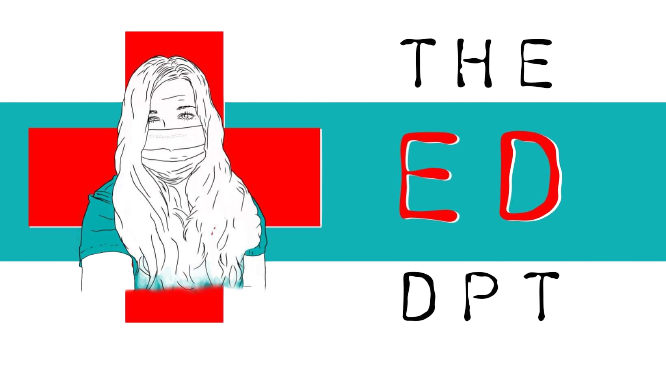Reader question & answer.
Question – What are you allowed to do in the ED, (Example – evaluation & care plan) & generally how does the process of seeing a patient go?
@mickharris99
We received this excellent question from @mickharris99. (Congratulations on passing your AT BOC!) Read on below for our answer.
Every Emergency Department Physical Therapy (ED PT) program is different. There are different models, such as embedded versus on-call. These programs are often staffed with physical therapists (PTs) from acute care rehab departments and outpatient rehab departments. In addition, each state practice act differs as does each facility’s protocol/credentialing process. Many emergency departments (EDs) have different zones such as fast track, observation, general, geriatrics, pediatrics, substance abuse/mental health, etc. So, all that is to say, (as every physical therapist must,) it depends.
That being said, let me share my experience. I practice in an urban academic medical center that is a level 1 trauma center. Our ED has over 100 beds! We have several different zones including a main ED, fast track area, medical observation, and mental health observation units. We staff one PT every day of the week and a second PT Monday through Friday. One PT primarily manages the fast track area and the other manages the remaining zones.
We practice mostly at top of scope according to the Colorado PT practice act. This includes dry needling, managing referrals, working as autonomous providers, and recommending imaging. Process flow in most ED PT programs generally follows a common theme. A provider, either a physician or Advance Practice Provider (APP), will most likely enter a consult request for PT. The PT then provides their evaluation and assessment along with any appropriate intervention and recommendations. Some ED PT programs will have the PT self-refer based on any cases they feel would benefit. PTs can also receive referrals from case managers, nurses, social workers, and inpatient hospital consulting teams.
Below are two very different (fictional) case examples to give you an idea of how we go with the flow.
Mrs. X is an 85 year old female, was brought in by ambulance after a fall. She was found down 24 hours after the fall. Past medical history (PMH) of dementia, osteoporosis, HTN, CVA, and DM. Patient uses a walker at baseline. Unable to ambulate in the department. PT evaluate & treat.
In this situation I would complete a chart review including any past notes from other providers in our health system. I ensure an understanding of all medical conditions, their stability, and any medications in play. I then speak with the Attending physician or APP to gather any collateral information from their examination, family discussions, or information that was passed on by EMS. If the RN, social worker, or case manager had any information I would also discuss that with them prior to seeing the patient. If there are any medications I am unfamiliar with I can discuss any concerns with the ED pharmacists.
Following this, I would evaluate the patient in their ED room, bed, curtained area, or wherever space allows. I begin each encounter with receiving a patient history with heavy emphasis on function and any new impairments limiting the patient this date. My goal for any patient in the ED is to help them transition to the next step, wherever or whatever that may be as successfully as possible.
In this case, our patient is clearly a fall risk who is having difficulty caring for themselves at home. Based on information gathered, I might also consult an occupational therapist (OT) to maximize the patient’s experience and any additional referrals. (Want to learn more about OT in the ED? Click here.)
After receiving the patient’s history I will complete a physical examination and evaluation of functional mobility, fall risk, home safety considerations, and any appropriate durable medical equipment (DME) needs that might improve the patient’s function or safety.
If during my evaluation, any concerns arise that might indicate need for further testing or medical workup, I will share that information with the medical team along with appropriate discharge recommendations to ensure patient well-being.
In a case like this, we might recommend sub-acute rehabilitation and partner with the case manager to make appropriate referrals. Alternatively, perhaps with family training, DME, and home services, Mrs. X may be able to return home with additional support.
As a second case example, consider Mr. Y.
Mr. Y is a 25 year old male with no PMH who presents immediately from halftime of his recreational soccer game by private vehicle through triage. His knee is swollen, warm, flexed, and painful. He is ambulatory with assistance and is concerned he “broke something.” Low suspicion for fracture, referred to PT for management.
Although this case is much different, I will follow the initial steps as before, and then take on the management of this patient. After completing the physical examination, I will take on the responsibility of determining a differential diagnosis for the knee pain along with appropriate intervention.
In this case, if I have a suspicion of a meniscus tear, I likely would not refer this patient for emergent imaging, but would place referrals for follow up for physical therapy and/or orthopedics as indicated. I would stabilize the injury, complete any treatment for pain relief/function, acquire needed DME, and provide all needed patient education.
If needed recommendations for work/recreation modification would be provided prior to discharging the patient to home with appropriate follow up resources. If during the course of my management of this patient I became concerned with any medical issues (as can frequently happen!) I would refer this patient back to our ED medical team for additional care.
There are roughly 100 ED PT programs in the U.S. and many more around the world. There may be more than 100 different experiences! While these two cases represent a very small subset of what an EDPT does, I hope it helps to answer your question about what we do and how the process might go.
New to ED PT and want to learn about the experience of other ED PTs? Check out the Feature Friday blog posts, listen to our podcast “Admitted or Not,” for ED PT interviews, or watch our Vlogcast on our Youtube channel.
For other ED PTs, what is the process like in your ED? I’d love to hear how you flow. Drop a comment below.


